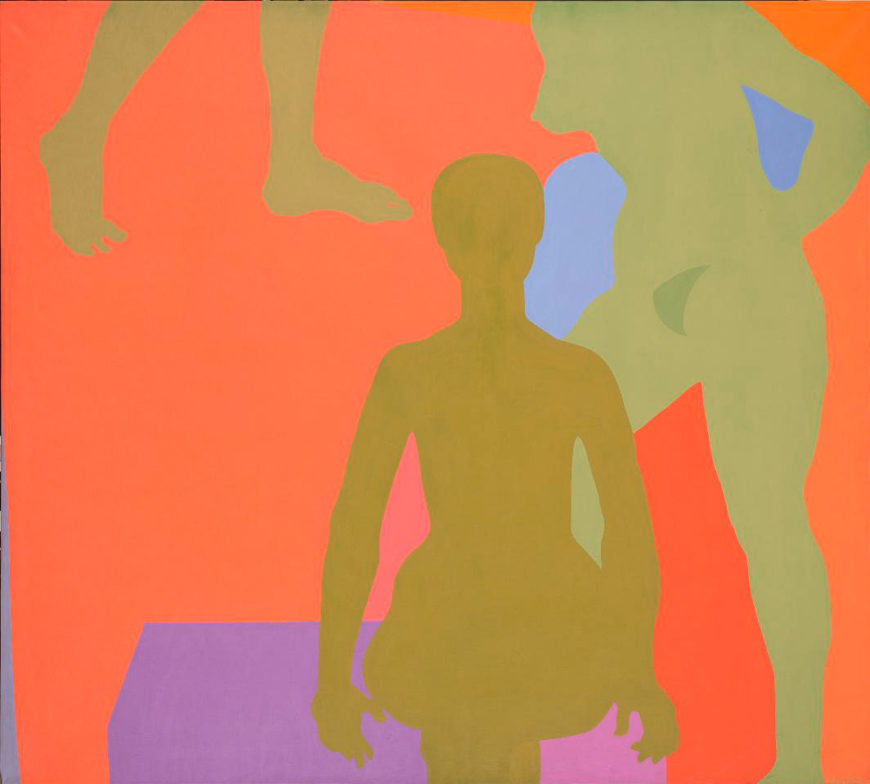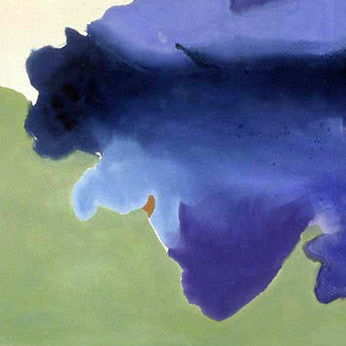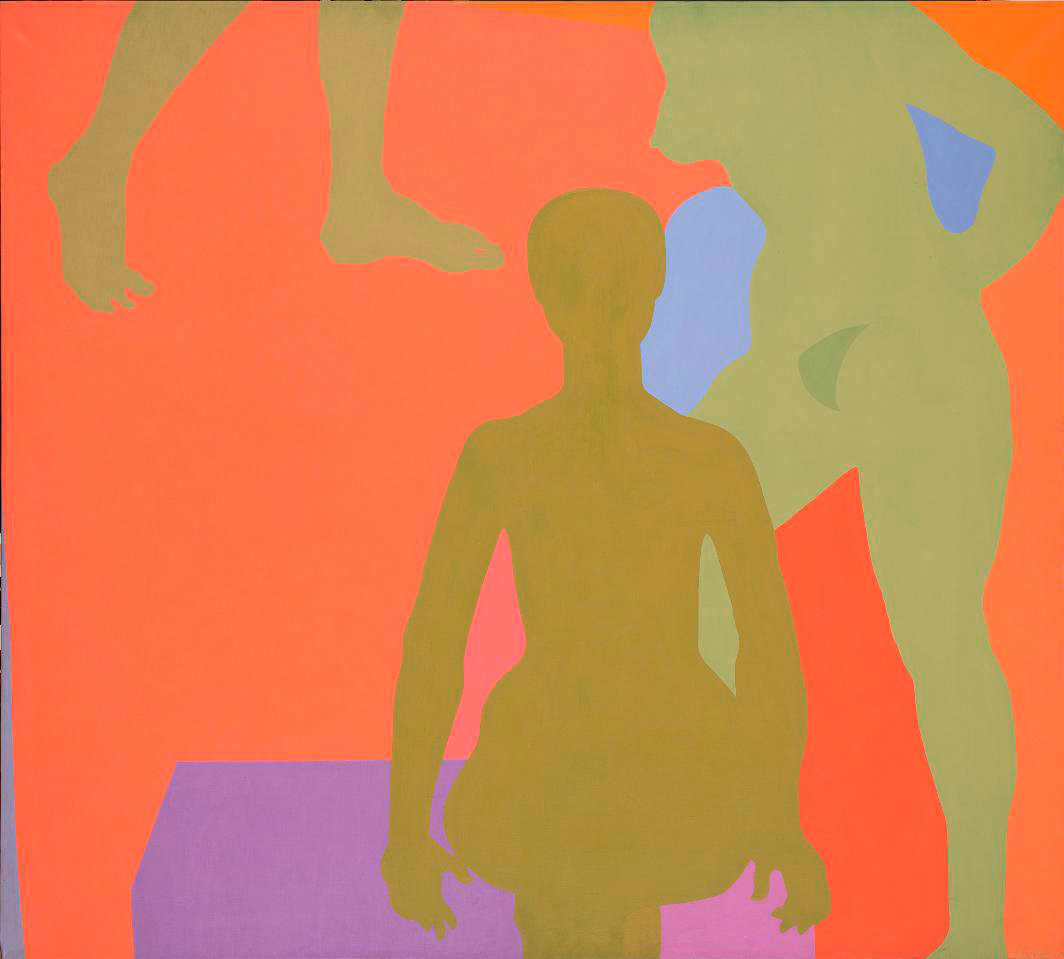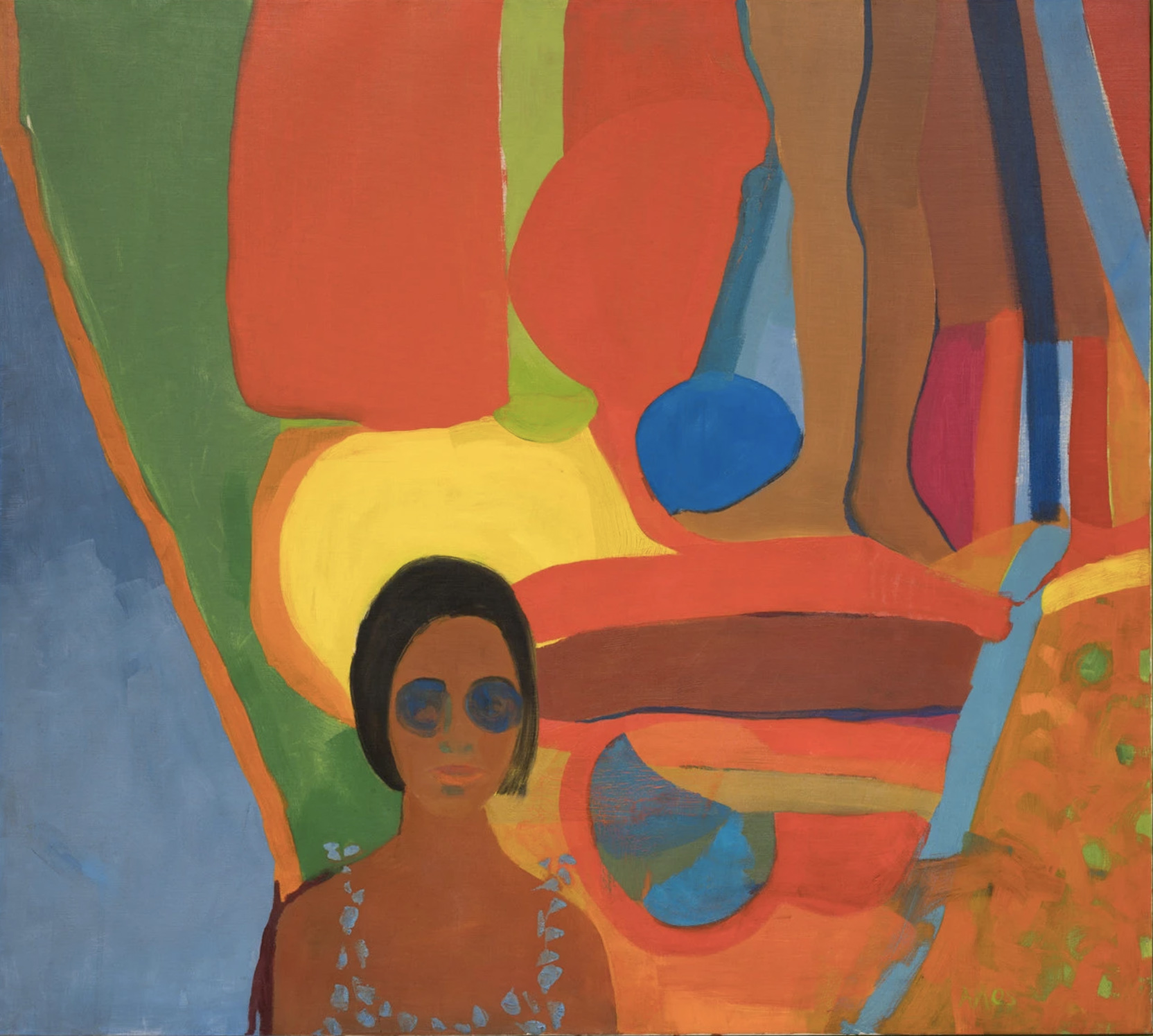
Kay WalkingStick, Me and My Neon Box, 1971, acrylic on canvas, 54 x 60 inches (Newark Museum of Art, © Kay WalkingStick)
A nearly life-sized silhouetted human figure sits atop a purple box at the center of Me and My Neon Box. The hard-edge lines that contour her warm-toned figure starkly contrast the surrounding field of neon coral. The subtle changes in tone and large sections of color complicate where the figure is located within the pictorial plane—do the planes of color move forward or recede? At the top left, the foot of another cropped figure is lifted, as if caught in the midst of taking a step. The same section of coral that anchors the stepping feet also frames the contour of the central figure’s left side, further tangling our ability to distinguish between figure and ground.
The only head we can see belongs to the central figure, sitting upright on the angled purple box. We soon realize that the figure’s hands cup the front edge and corner of the box. Though the silhouette includes no internal drawing, and thus no facial features, we sense the figure’s gaze looking out towards us. But who is this? As hinted at in the title of this painting, the chromatic figures in Me and My Neon Box are based on the body of Kay WalkingStick, the artist who created this composite self-portrait in 1971. The painting belongs to a series of works made by WalkingStick from 1969 to 1973, featuring multiple naked silhouettes, primarily of her own body, in alternating pastel and vivid colors.
I wanted to be part of this activity that was going on in New York at the time, but I wanted to be different. Kay WalkingStick [1]

Helen Frankenthaler, The Bay, 1963, acrylic on canvas, 6′ 8-7/8″ x 6′ 9-7/8″ (Detroit Institute of Arts, © Estate of Helen Frankenthaler)
Around 1962 and in her late 20s, married with two children living in northern New Jersey, WalkingStick began to take regular trips to New York City. There she would visit art galleries and museums, studying the work of painters including Helen Frankenthaler, Ad Reinhardt, and Sam Gilliam. The art world experienced by WalkingStick in the mid-to-late 1960s was one of openness and new possibilities. Abstract Expressionism (or New York School painting), which used gesture to respond to the devastating conditions in the aftermath of World War II, was no longer center stage, replaced in the art press by color field painting. The application of pure color with subtle tonal variation to create a flattened composition was characteristic of many younger color field painters like Frankenthaler, and with vigorous support of key art world critics, the practice continued to develop into the 1960s. The introduction of acrylic paint and the action of materials through techniques of pouring, taping, and staining provided an entry point for many younger artists, including WalkingStick, to make art that addressed their current realities relating to social and sexual liberation.
My body, my box

Kay WalkingStick, Me and My Neon Box, 1971, acrylic on canvas, 54 x 60 inches (Newark Museum of Art, © Kay WalkingStick)
WalkingStick’s Me and My Neon Box engages and adapts the tenets of color field painting with great originality; as she describes the series, it is “hard-edge acrylic, but it is figurative rather than abstract.” [2] As the clean edges of each figure’s contour meets the surrounding environment, the hue shifts, to create a flat, yet spatially complex painting. The warm yellow-green-brown tones of the figures, converge with the equally bright, yet matte, fields of orange, blue, and purple, making it difficult to separate the figures from their environment. Our perception of figure and ground is challenged by WalkingStick’s use of color and line. The bodies shape the space they inhabit (rather than the reverse): the feet delineate the coral-hued ground, the central figure grasps the edge of the box, and the bent arm of the standing figure on the right side creates a pocket of pastel blue. WalkingStick, among many artists during this period, including Emma Amos, was interested in new ways of handling color and figuration to examine the coding of space.
WalkingStick’s use of the silhouette originates from the experience of going to the beach and observing her shadow, its dual function as both index of her body and part of the sandy beach. [3] Her experience at the beach reveals WalkingStick’s nuanced understanding of the social production of bodies within space. The artist’s flattened figure is shaped by, is a part of, and gives form to her environment simultaneously. Me and My Neon Box encapsulates a critical period in WalkingStick’s artistic practice when she begins to use her own body as a mode to examine interconnected questions about gender, race, and sexuality in social space.
My body, freedom and power
I was raised to be a feminist.
Kay WalkingStick [4]
WalkingStick’s silhouettes, or shadows, are defined by color and, as WalkingStick pointedly states, they are “not white girls.” [5] WalkingStick’s father, a citizen of the Cherokee Nation, was not an active part of her life. Raised by her Scottish-Irish mother, the way WalkingStick viewed her Native and gender identity was strongly shaped by her mother’s influence. She would say, “Stand up straight Kay, you’re a Cherokee, be proud of who you are,” and “[I]t’s a man’s world, Kay. All you have to do is be better than the men.” [6] Growing up surrounded by working women and with the continual reminder that she—a Cherokee woman—better “make something of herself” drove WalkingStick to make a career of her own. [7]
Although WalkingStick was made aware of society’s white, patriarchal structures at an early age, she shifted her artistic practice to focus on topics of gender and sexuality at the advent of the women’s movement and sexual revolution of the 1960s and early 1970s. While WalkingStick was not a publicly active figure in the women’s movement, she did “read all the books that everybody read” and “went to a few meetings.” [8] The meetings that WalkingStick attended were known as consciousness-raising groups, where women would draw connections between their private, social, and public lives, becoming aware of the hegemonic and patriarchal structures that commonly shaped their daily lives. Participants in these groups, and women interested in feminism more broadly, often read books that drew these connections, including Betty Friedan’s The Feminine Mystique (1963) and others. Within this feminist context and consciousness, WalkingStick formed a different relationship to her body and her sexuality:
“[J]ust accepting the fact that I’m a woman in a woman’s body, having a good time in a woman’s body is in these paintings. And the feminist kind of view of ourselves as being potent, strong individuals, sexually as well as everything the other way, was in these paintings. These were not about my heritage at all.” Kay WalkingStick [9]

Kay WalkingStick, Me and My Neon Box, 1971, acrylic on canvas, 54 x 60 inches (Newark Museum of Art, © Kay WalkingStick)
The only interior details in the painting can be seen in the rightmost silhouette in Me and My Neon Box’s composition: her breast and the triangular shadow painted in her pelvic area alluding to her vulva. The eroticism of WalkingStick’s silhouettes develops alongside the rise of erotic art during the sexual revolution of the 1960s. [10] But while some erotic art with a pop sensibility created during this period reinscribed gendered dynamics of spectatorship by objectifying women’s bodies for the heterosexual male viewer, apart from the breast and vulva, Me and My Neon Box’s flattened space and vast areas of flat color limits visual access to her body.
By sharply cropping her form with the painting’s edge and the other means of abstraction that she employs, WalkingStick resists the misogynistic art historical trope of depicting nude women’s bodies as passive objects for visual pleasure. She asserts that her figures are not representations of “nudity”; rather, there is a “joyousness in their nakedness.” [11]
Of the artist’s three silhouettes moving and interacting across space, only one shadow gives a fleeting glimpse of her nakedness through profile and shadow. Through her subtlety, WalkingStick emphasizes the everyday, matter-of-factness of her body, rather than centering an idealized perspective. WalkingStick’s reversal of nude to naked bodies is common to feminist art-making and writing of the period. The multiple versions of her own body in Me and My Neon Box—more subject than object—render vivid WalkingStick’s experience as a Native woman and sexual being finding freedom and power in her body.
Me and My Neon Box embodies WalkingStick’s remarkable artistic practice in the early 1970s, when she was working through questions in painting simultaneously and in dialogue with questions of sexuality, gender, and race. She creates a space where her naked body is uninhibited by her environment and denies a direct relationship to the viewer. This iridescent space and neon box are hers.





